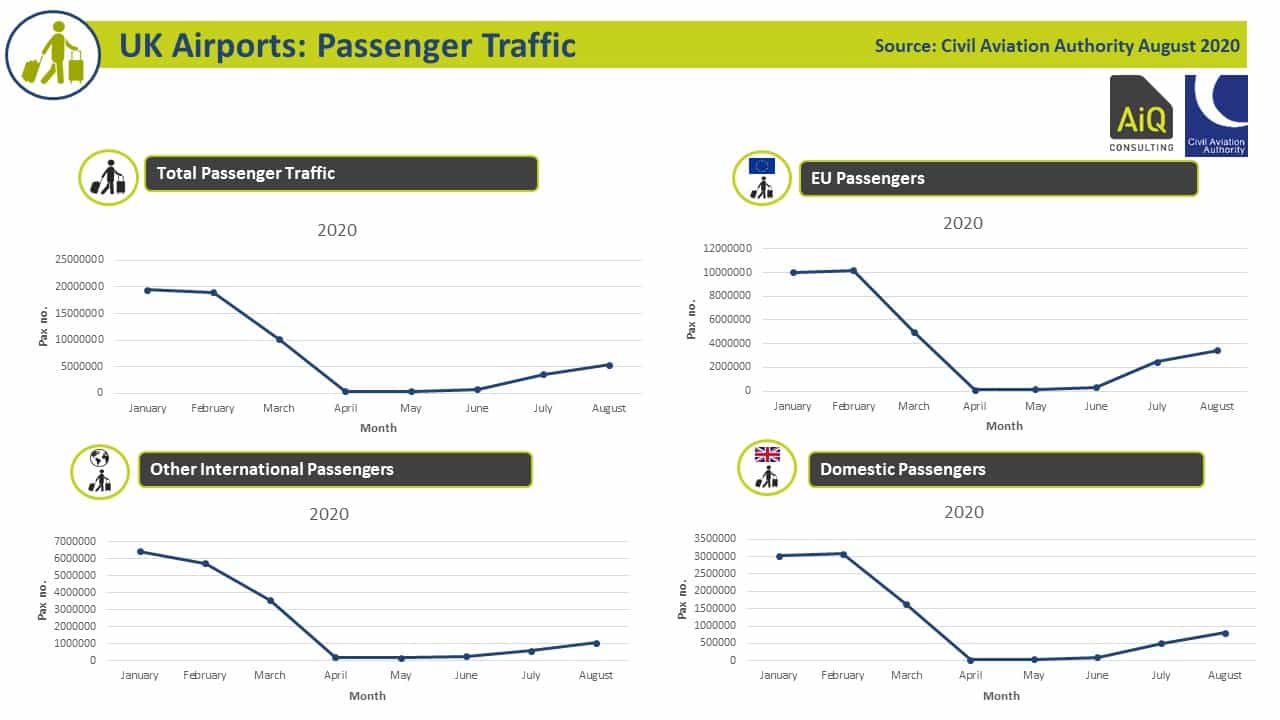
At AiQ Consulting our dedicated airport planners analyse and model all processes across an entire airport including passenger, baggage, transfer systems and ground support equipment – giving the big picture as well as highly detailed insights and analysis for effective decision making. Our modelling brings complex data to life to solve complex airport problems and improve operational efficiency.
During the uncertainty of the COVID-19 pandemic, we have tracked the route to airports recovery as seen in a previous blog. To provide more clarity to the recovery phases, our team have extracted Civil Aviation Authority (CAA) informative data to track UK airports monthly activity during 2020, representing these statistics visually in graphs to provide a clear vision. The raw data can be found on CAA website here.
The data used in our below graphs is based on 51 UK airports.
UK Airport Air Traffic Movements (ATMs) 2020

The above data is based on commercial movements only and provides an instant view of the dramatic impact of COVID-19 on UK airports. ATM’s sharply declined throughout March to a low point of 3,079 in April and a further decline in May to 2,765. Flights were cancelled as the COVID-19 pandemic escalated with the increase of infection rate and lockdowns throughout the world. In May, flight movements increase slowly as lockdown restrictions are eased and the government relaxes rules.
With new government restrictions and further local lockdowns enforced in August, we expect to see a slight decline in ATM’s and increased cancelled flights in the September and October’s data. Look out for the next months’ blogs on this.
UK Airport Passenger Traffic 2020

For a more meaningful representation of how COVID-19 has impacted UK airports, it is important to analyse passenger numbers to help operations plan for future recovery.
In January this year, pre-COVID-19, the total number of passengers at UK airports was 19,487,176. The dramatic effect of the COVID outbreak resulted in passenger numbers sharply decreasing to 335,808 in April bringing the aviation industry almost to a standstill. In June, passenger numbers increased gradually as airports reopened terminals and airports gave passengers the confidence to fly again with the government relaxing restrictions but with enforced travel quarantine rules. In August, numbers reached the highest since April with 5297056 passengers, mainly from EU and domestic passengers.
Look out for a further in this series on UK airport cargo traffic which will be published next week.
Airport Efficiency
As airport experts and data ‘nerds’ who provide clarity, the AiQ team are in their element with visually tracking CAA raw data and we shall continue to publish the visual representative of CAA statistics each month for the rest of the year to support airports in understanding the route to recovery to help manage an efficient airport. As ACI Europe Ex-Director General, Angela Gittens states –
‘Effective decision-making will depend on a good understanding of what the path to recovery will be. Traffic forecasts will be essential for defining staffing and operational levels, capital investment requirements, and core business decisions on airport charges.
Predicting recovery with high levels of uncertainty and ambiguity may require airports to create entirely new forecasting frameworks that will be flexible enough to incorporate new inputs as better information becomes available.’
To find out how AiQ can help you make effective operational decisions and operational efficiency recommendations during this uncertain time, contact us or discover more about our Airport Recovery Planning Service.

